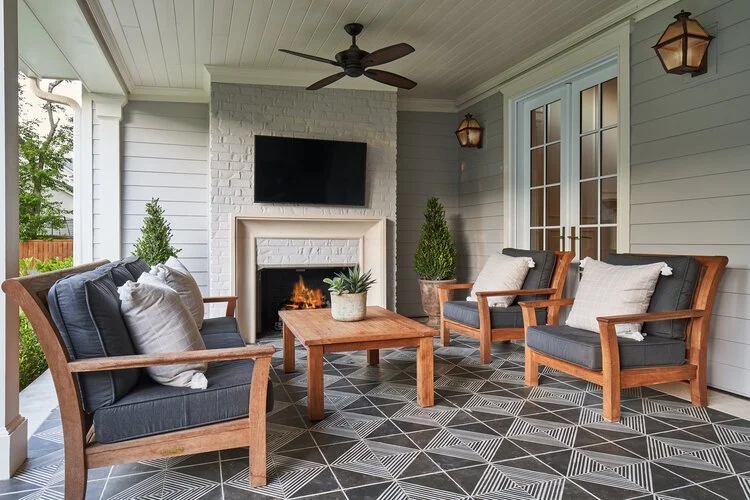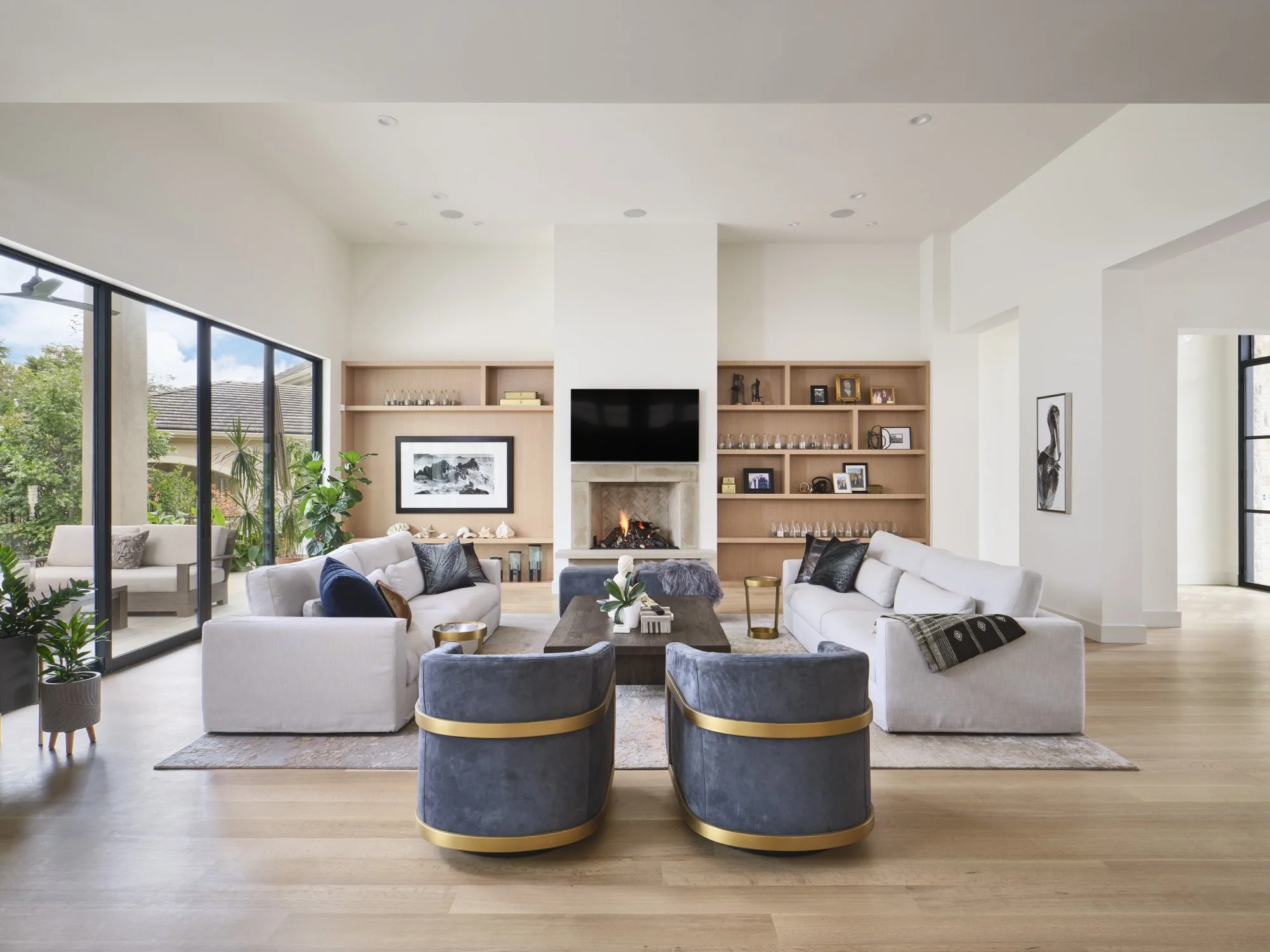The Top 8 Materials to Use on a Fireplace Surround
Our Austin Architects Share the Best Materials to Use on Your Fireplace and Which One’s to Avoid
A fireplace serves as the main focal point of your room. So, it’s important to choose a beautiful material for your fireplace surround that coordinates with the architectural style of your home and interior decor. However, fireplace surrounds also need to be durable and stand up to temperatures as high as 1,000 degrees Fahrenheit. Unfortunately, not every material option out there can take the heat! Our Austin architects share the top eight materials to use on a fireplace surround as well as four materials to avoid at all costs.
Stacked Stone Fireplace by DK Studio
Fireplace Surrounds Need to be Non-combustible
Before shopping for fireplace surrounds and finishing materials, familiarize yourself with the parts of a fireplace and the specifications required for each item. The three main components you will be shopping for are a fireplace surround, hearth, and mantel. The fireplace mantel can be made out of any material (as long as it is far enough away from the firebox opening). However, the hearth and surround need to be non-combustible.
Non-combustible materials include tile, stone, and brick. Typically, the hearth will extend 16 to 18 inches from the firebox opening, and the surround will be 8 to 12 inches wide. However, the materials used on the hearth and surround can flow as continuous flooring in the room or as an entire wall finish if desired.
Pay attention to local building codes and the regulations they have on your particular fireplace model. Wood, gas, and electric fireplaces require different measures to ensure protection. For example, electric fireplaces are less of a fire hazard than wood-burning because the flames are artificial. While a wood-burning fireplace requires a hearth, it is optional for electric models.
Stone Mantel Fireplace by DK Studio
The Top 8 Materials to Use on Your Fireplace Surround
Here are eight of the best materials to use on your fireplace surround for a durable, safe, and beautiful design. All of these material options are non-combustible and adhere to the National Fire Code.
1. Brick
Brick is one of the most classic and traditional fireplace surround materials out there. There is a range of colors and sizes, from skinny mid-century inspired red bricks to oversized rustic-look bricks. Bricks can be left unfinished or painted for a cleaner look. Brick is a perfect option for Craft Revival or Cottage-style homes.
Brick Fireplace by DK Studio
2. Plaster
Plaster is made from a mixture of aggregates, sand, cement, and water. It is similar to stucco but used in interior spaces with finishes ranging from sleek and modern to rustic. A plaster fireplace surround would coordinate well in a Mission-style home.
Plaster Fireplace by DK Studio
3. Tile
There are many fireplace-safe tile options, including ceramic, porcelain, glass, and concrete tile. Tile can be used as a surround accent or extend over the entire fireplace wall for a dramatic focal point. With millions of colors, patterns, and designs, there is a tile option to fit any space and architectural style.
4. Concrete
Concrete fireplace surrounds have a similar look and feel to plaster fireplaces but with a modern industrial edge. Concrete is an incredibly durable and flexible material. It can be used as a coating around the fireplace walls or poured into intricate molds to form a hearth bench and mantel.
5. Sheet Metal
Metal-clad fireplaces create a bold and unexpected visual impact. They have a contemporary and industrial feel and may not feel cohesive with more traditional home designs. With a wide range of metallic finishes available, there is room for customization on shine, color, and visual warmth.
6. Stacked Stone
Stacked stone fireplaces evoke the warm feeling of waking up on a snowy morning in a cozy cabin. Stacked stone is an excellent option for log cabin and Texas Hill Country-style homes. However, this rustic look can be incorporated into other traditional designs as well.
Stacked Stone Wall Fireplace by DK Studio
7. Stone Slab
While stacked stone fireplaces feel rustic, stone slab fireplace surrounds feel luxe and modern. Marble and granite slabs can frame the fireplace surround or extend to cover the entire wall for a dramatic effect.
Slab Fireplace by DK Studio
8. Cast Stone
Cast stone is manufactured using a combination of stone aggregate and concrete, making it easy to mold into fireplace surround and mantel designs. Typically, a cast stone surround will come as a single unit and range from traditional to modern styles.
Stone Fireplace by DK Studio
4 Materials Not to Use on Your Fireplace Surround
Our Austin architects say never to use these four materials on your fireplace surround — no matter what!
1. Vinyl Tile
It may be tempting to find easy or cost-saving solutions to update your home during your first remodel. However, we discourage you from updating your fireplace surround with peel and stick vinyl tile. Vinyl tile won’t be as fire resistant as other materials, and the heat from the fire can pose a safety risk and damage the material over time. Instead, invest and upgrade with durable ceramic, porcelain, glass, or concrete tiles.
2. Wallpaper
While you can paint brick and plaster fireplaces to revive them, you cannot wallpaper over your old fireplace surround. Wallpaper is combustible and presents a massive safety risk when used in the wrong applications.
3. Shiplap
While shiplap can be installed around a fireplace, it cannot meet the fireplace box opening and be used as a fireplace surround. This is because combustible materials like wood need to be installed at the proper distance from the firebox opening. Plus, we think it’s time to break up with the modern farmhouse trend anyway.
4. Patterned Tile
While tile is a non-combustible material safe for use on fireplace surrounds, we encourage our Austin architecture clients to be conscientious when using patterned tile. Using patterned tile requires additional measurements to ensure the pattern is not cut or disrupted. For example, if your fireplace surround is one and a half tiles wide, the design on one of the tiles will be cut in half for installation. In some cases, this creates an undesirable appearance. To avoid this, make sure to measure and extend the surround to a two-tile wide diameter.







